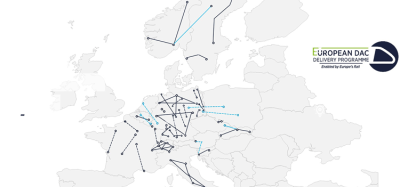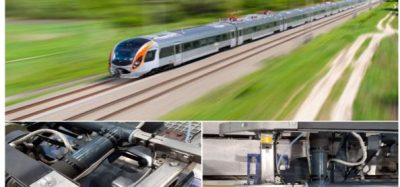What is needed to accelerate the overall deployment of ERTMS?
Posted: 13 July 2022 | Alberto Mazzola, Enno Wiebe | 1 comment
In this article, the Community of European Railway and Infrastructure Companies’ (CER) Alberto Mazzola, Executive Director, and Enno Wiebe, Technical Director, give a snapshot of ERTMS development in Europe, but also explain that a wider strategy is needed in order to achieve full and harmonised deployment.


ERTMS in a nutshell
The European Rail Traffic Management System (ERTMS) is a single European signalling system that ensures the safety and interoperability of the European railway system. ERTMS aims to replace the different national train control and command systems in Europe and, as such, offer the necessary conditions for uninterrupted, safe, efficient, and fast railway services.
The system underpins interoperability throughout the railway system in Europe and is inevitably a pivotal element of the future digital European railway system, bringing better and new business opportunities. On a global scale, ERTMS is now the standard for (digital) train control and communication.
ERTMS as a system is composed of the following major elements:
- ETCS (the European Train Control System), an automatic train protection system at European level
- GSM-R (Global System for Mobile Communications – Railway), a radio system for providing voice and data communication between the track and the train. The successor of GSM-R is the Future Railway Mobile Communication System (FRMCS)
- ERTMS operating rules.
ERTMS deployment – state of play
Despite having mature and managed ERTMS specifications, European trackside and onboard ERTMS deployments on the Trans-European Transport Network (TEN-T) core and comprehensive network are seriously lagging behind targets for a full and harmonised deployment.
ERTMS, as a pan-European system, is therefore only partially fulfilling its promise of being the future-proof interoperable enabler of digitisation of the railways, that leads to higher safety, quality of service and capacity gains.
Class B legacy systems
More than 150 years of national rail politics in Europe have led to a large variety of technical and operational solutions, a lack of interoperability and, consequently, obstacles for cross-border rail traffic. This applies in particular to Control Command and Signalling (CCS) where the use of national systems, the so-called class B systems, is still predominant. Although the foundations for ERTMS were created over 20 years ago, its European-wide rollout is still in its infancy. However, as more and more suppliers of class B systems have announced their discontinuation, the pressure on the rail operating community to equip infrastructure and vehicles with ERTMS and to decommission national systems, is increasing.
A deployment strategy
In order to accelerate the overall deployment of ERTMS, a parallel and harmonised ERTMS trackside and on-board deployment, coordinated between infrastructure managers and railway undertakings/vehicle owners, is needed.
Indeed, the cost-benefit analyses and experiences carried out so far have highlighted that the most effective strategy to fully exploit the potential offered by ERTMS applications in terms of safety, capacity and maintainability, is to implement ERTMS in conjunction with the decommissioning of the national class B system.
In order to accelerate the overall deployment of ERTMS, a parallel and harmonised ERTMS trackside and on-board deployment, coordinated between infrastructure managers and railway undertakings/vehicle owners, is needed. The benefits will be shared with railway undertakings/vehicle owners in terms of funding and financing mechanisms. Adequate and smart support measures for railway undertakings and infrastructure managers must be put in place at national and EU level to ensure a smooth and affordable on-board deployment without threatening the financial (and operational) viability of railway undertakings.
Deployment trackside and onboard (including the FRMCS) must ensure both innovation and a sustainable migration process, for instance through backward and forward compatibility to the extent that is possible and safe. For the migration period, the class B train protection systems must remain on-board. The forced update of the system introduced by the ERTMS error correction process shall not endanger the businesses of the actors. Only if safety or technical compatibility is endangered in certain areas of use, the forced update of the system should be required. Reauthorisation in conformity to a type or generic system already certified and authorised for serial vehicles or for a trackside subsystem (e.g., duplication or extension of a authorised trackside or on-board subsystem without adding new functions) must not lead to any unnecessary ‘standstill time’.
Infrastructure
A total of 47,890km of the railway network, considered as Core Network Corridors (CNC) of the 118,037 km-long TEN-T Network, is expected to be fully equipped with ERTMS by 2040 (N.B. 226,726 km is the total length of the EU’s railway network).
In 2021, 6,713 km of the CNC was in operation with ETCS, which is only 43 per cent of the European Deployment Plan (EDP) target for 2023. The EU deployment goal has encountered some delays in the short-term. Nonetheless, the medium- and long-term outlook for trackside deployment is promising.
Rolling stock
Almost 90 per cent of Europe’s commercial fleets operating on the CNC are to be renewed in the upcoming 20 years, more than 20,000 vehicles expected between 2021-2030 and a further 11,000 vehicles between 2031-2040.
By the end of 2019, around 5,700 vehicles were equipped with ERTMS. Forty per cent of this volume were newly purchased vehicles and 60 per cent were retrofitted railway vehicles. This volume represents only 12.5 per cent of the European commercial railway fleet. Between 2015 and 2019, approximately 5,000 new vehicles have been put into operation in Europe.
Approximately 2,700 new vehicles were placed on the market without ERTMS during this period due to exemptions under the TSI CCS.
Almost 90 per cent of Europe’s commercial fleets operating on the CNC are to be renewed in the upcoming 20 years, more than 20,000 vehicles expected between 2021-2030 and a further 11,000 vehicles between 2031-2040.
ERTMS operational rules harmonisation
Besides having standardised and interoperable products, a harmonisation of ERTMS operational rules is essential in order to fulfil the potential of ERTMS contributing to the modal shift required under the Green Deal. Harmonised common operational rules are to be applied on lines equipped with ERTMS only. This target should be a pivotal part of the upcoming Europe’s Rail Joint Undertaking System Pillar. However, not all rules can be harmonised, especially when still needing transitions to class B tracksides with their system related rules.
The Europe’s Rail Joint Undertaking System Pillar
Europe’s Rail, composed of an Innovation and a System Pillar, the largest European railway research and innovation programme ever, will deliver activities worth €1.2 billion. The purpose is to improve the European railway system to offer better services for the European citizen, passengers, and freight. The System Pillar proposes to contribute to this approach by defining a set of application profiles based on harmonised objectives and requirements and deriving harmonised operational processes, using formal architecture approaches, such as the concept of layered functional architecture, as deployed for several decades in many industries such as automotive, aviation, defence, energy, high tech, IT, software, telecoms, to frame the development of the rail system, and harmonising this system architecture approach at European level, including operational rules, engineering rules and implementations. The work of the System Pillar is not a complete change for the railway system. Rather, it consists in integrating new scientific knowledge and other industry best practices in order to accelerate and better organise its evolution. The optimisation task of the System Pillar is to design an architecture that, on the one hand, standardises the interaction of new and advanced methods and technologies. On the other hand, it will improve several architecture qualities.
Development, procurement, and liabilities
The future ERTMS onboard technology should have maintainability and upgradeability by design, supported by an open plug-and-play architecture. Existing vehicle retrofit with modern ERTMS onboard technology will be supported by an open interface architecture, enabling interfacing with several other technologies on the train, without creating vendor-lock-in when needing to upgrade/retrofit. CER, the Community of European Railway and Infrastructure Companies, therefore strongly supports the OCORA (Open CCS On-board Reference Architecture) developments. ERTMS (sub-)systems and components should be procured in a mature marketspace, having upgradability and maintainability according to ERA managed specification management and reliability requirements at its core. ERTMS project risks should be far more reduced than today, and liabilities shall be far better known prior to project execution, foremost by eliminating track-vehicle system integration risks. Further industrialisation of the (accelerated) ERTMS rollout is needed, with standardised and compatible products for trackside and onboard, reducing present day integration risks. An important role here is to be played by infrastructure managers: maximal reduction of having specific solutions (as resulting from National Technical Rules) and the supply industry: creating industrialised production concepts, which are easily upgradable, updatable, maintainable and allow for multi-vendor products interfacing with their ETCS onboards. Lessons learned from earlier ERTMS trackside and onboard deployments should be considered. Market/governance failures as experienced today should be avoided. CER sees this as a lesson for the future System Pillar, as well as for the exploitation of the potentials in the Innovation Pillar.
Outlook
The European demand for the retrofitting/renewal of the fleet is expected to peak between 2024 and 2028 (EDP). Foreseen upgrades (Baseline 2 to Baseline 3) and upgrade cycles of every five to 10 years (due to the Future Railway Mobile Communication System (FRMCS), Automatic train operation (ATO) Level 3, incompatible CR’s etc.) are at this moment excluded from the analysis of the EC and can be expected starting around 2027-2028, which will likely cause additional volumes during these peak years.
Paving the way to an accelerated ERTMS deployment
ERTMS is one of the few large-scale European digital infrastructures and, as such, must be properly and rapidly deployed in all of Europe.
ERTMS is one of the few large-scale European digital infrastructures and, as such, must be properly and rapidly deployed in all of Europe. ERTMS deployment must be boosted and to this purpose, a future strong and centralised EU Level ERTMS governance is needed, with governing funding, National Implementation Plans (NIP) planning, resourcing, market uptake, migration, and transition. CER foremost sees the introduction of ERTMS as a CCS core technical system hub, bringing the railway system, as well as the Control Command and Signalling (CCS) system in particular, to a next level. Close cooperation between EU and Member States is paramount, to set up and manage the centralised EU Level ERTMS governance. An accelerated ERTMS rollout is vital for the modal shift envisaged in the Green Deal, under the precondition of having suitable funding and financing options in place. An industrialisation of ERTMS is needed to tackle the existing bottlenecks with ERTMS deployment in parallel to a synchronised and harmonised ERTMS deployment of tracksides and onboards.




Related topics
European Rail Traffic Management System (ERTMS), European Train Control System (ETCS), Future Railway Mobile Communications System (FRMCS), Global System for Mobile Communications – Railway (GSM-R), High-Speed Rail, Operational Performance, Rolling Stock Maintenance, Safety, Signalling, Control & Communications
Related organisations
Community of European Railway and Infrastructure Companies (CER), European Union (EU), Europe’s Rail Joint Undertaking (EU-Rail)









An optimised traffic management system improves without a doubt management operations with automated processes for data integration and exchange with other rail business services.
European-wide deployment of ERTMS and CCS investments need to proceed as quickly as possible, with decommissioning of Class B systems, at least as regards the Core Network, possibly shortly after 2030 with predictable and reasonable deadlines.
Dr. Güntürk Üstün